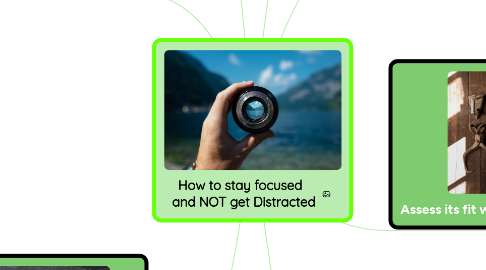
1. Understand the concept of switching costs
1.1. I only look into a new tool
1.1.1. when (a) it has something that my current tools can’t provide
1.1.2. (b) there are very strong reviews from multiple sources
1.2. Otherwise
1.2.1. I simply take a cursory glance at what’s available
1.2.2. and return to my work priorities
1.3. when you shop even though you don’t need anything
1.3.1. you’re invariably going to end up buying something
1.4. switching costs
1.4.1. which are invisible costs incurred
1.4.1.1. as a result of switching to something new
1.4.2. Switching costs can be monetary
1.4.2.1. They can be the time taken to learn a brand new system
1.4.2.2. They can also be the mental cost of changing your focus
1.5. When you keep switching to
1.5.1. new ideas, new projects, and new tools
1.5.2. you are just incurring switching costs all day long
1.5.2.1. and getting nothing done
2. Adopt a “wait and see” approach
2.1. When you’re unsure
2.1.1. it helps to adopt a “wait and see” approach
2.2. Products that claim to be the best
2.2.1. often get replaced by better products one to two years later
2.3. My personal approach
2.3.1. when I feel 50/50 about something
2.3.2. is to wait and see
2.4. If it’s a new tool
2.4.1. I take a look at the company’s background
2.4.2. preview the tool
2.4.3. and assess if I really need it
2.5. For new online tools
2.5.1. there are often integration issues
2.5.2. and unknown bugs
2.5.3. and it can be costly
2.6. Unless this is something that I need to use now
2.6.1. and I have no other alternative
2.6.2. I find that “waiting and seeing”
2.6.2.1. a much more prudent approach
3. Differentiate between shiny objects and real opportunities
3.1. Shiny objects are things that look good and exciting
3.1.1. but are really distractions at the end of the day
3.2. There are many new products these days
3.2.1. that look promising
3.2.2. but don’t add value to your work and life
3.3. By the time you are done with it
3.3.1. you realize you have no need for that tool
3.3.2. after which you get distracted by another shiny object
3.4. Keep a watch out for real opportunities
3.4.1. and be ruthless in saying no to shiny objects
4. Learn more about Mind Mapping ------------>
5. Understand that new does not mean better
5.1. To be clear
5.1.1. addressing the shiny object syndrome
5.1.2. is not about ignoring every new thing
5.2. it is important to keep in touch
5.2.1. with the latest trends and updates
5.3. However
5.3.1. you waste your time chasing trends
5.3.2. rather than getting things done
5.4. Just because someone just launched something new
5.4.1. doesn’t automatically mean that it’s better
6. Learn to see past the hype
6.1. There are constantly new
6.1.1. shiny objects in the online world
6.1.1.1. New startups
6.1.1.2. new products
6.1.1.3. new services
6.2. But see past the hype
6.3. While people may brag about
6.3.1. how great a product/service is
6.3.2. what’s good for others may not be good for you
6.4. Even though a company can promise the world
6.4.1. on what their product can do
6.5. Rather than jump headfirst into something
6.5.1. question how it fits in with your priorities
7. Assess its fit with your work (and life)
7.1. Before jumping into a new idea or tool
7.1.1. assess its fit with your work and life
7.2. Ask yourself
7.2.1. Is this what I really need?
7.2.2. Will it add value to my work and life?
7.2.3. What are the pros vs. the cons of doing this?
7.3. Only do something if it’s what you need
7.3.1. and it adds genuine value to your work and life
7.4. Just because others are doing something
7.4.1. doesn’t mean you have to
8. Improve your signal-to-noise ratio
8.1. The best way to manage distraction
8.1.1. by managing the sources of distraction
8.2. When you are part of
8.2.1. groups
8.2.2. newsletters
8.2.2.1. that keep recommending new products, new offerings
8.2.3. it disrupts your focus and train of thought
8.3. Evaluate your social media news feeds
8.3.1. Facebook group memberships
8.3.2. email subscriptions
8.3.3. and RSS feed subscriptions
8.4. What is your noise-to-signal ratio for each channel?
8.5. Noise refers to
8.5.1. information that’s irrelevant to you
8.5.2. while signal refers to
8.5.2.1. information that’s useful and relevant
8.6. A high noise-to-signal ratio means
8.6.1. the channel has a high proportion of unhelpful
8.6.2. irrelevant suggestions (noise)
8.6.2.1. vs. helpful suggestions (signal)
